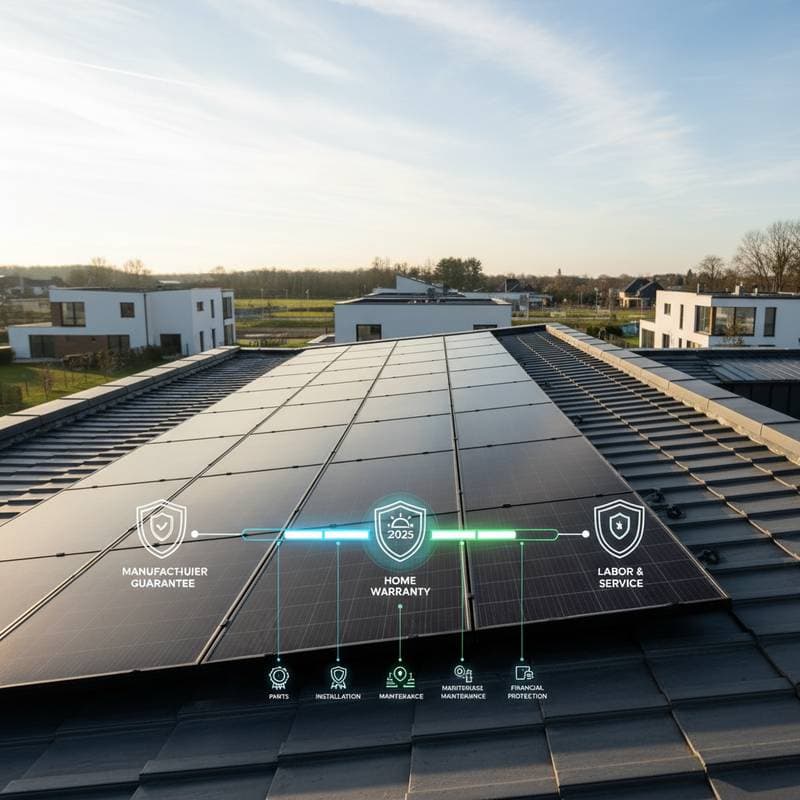- Difficulty level: Straightforward for typical homeowners
1. Evaluate Existing Warranties
Examine warranties for panels and inverters. Standard panel warranties include product guarantees and performance assurances. Manufacturers typically cover parts but not labor. Note expiration dates and specific exclusions for each.
2. Reach Out to Your Home Warranty Provider
Inquire about solar coverage options as an add-on. Plans may refer to it as a solar energy system or renewable energy rider. Obtain a sample contract and review details on limits, exclusions, and service fees.
3. Assess Payout Limits
Every claim features a maximum payout amount. Coverage typically spans from several hundred to several thousand dollars per incident. Opt for higher limits if the system includes advanced inverters or battery integration, though these increase premiums.
4. Confirm Technician Expertise
Verify that the provider employs technicians certified in solar repairs or electrical systems. A standard HVAC specialist might lack skills for inverter troubleshooting or roof wiring assessments.
5. Align with Homeowners Insurance
Homeowners insurance manages weather or fire-related damage. The home warranty focuses on mechanical or electrical breakdowns. Clarify boundaries to prevent duplication in coverage.
6. Finalize Agreement and Arrange Inspection
Certain providers require a system inspection prior to approval. Present evidence of recent cleaning, inverter testing, or performance reports. Coverage activates upon approval.
7. Submit Claims Promptly
If the system ceases power generation, contact the warranty provider before engaging a contractor. Independent repairs risk claim denial. Maintain photographs and meter readings to document the problem.
Practical Advice: Organize serial numbers and installation documents in a dedicated file. Providers often demand these for claim validation.
Pricing Details
Standard Annual Cost: $300 to $900 for solar coverage within a complete home warranty package.
Cost-Increasing Elements:
- Extensive systems with numerous panels or several inverters
- Roofs featuring steep angles or intricate mounting configurations
- Inclusion of battery storage components
- Elevated labor rates in the local area
Cost-Reducing Elements:
- Integration with an active home warranty plan
- Systems under ongoing manufacturer warranties
- Flat roofs or those with simple access
- Discounts from providers for long-term commitments
Choosing Replacement Over Repair
For inverters or panels beyond their typical lifespan or outputting under 80 percent of capacity, full replacement often proves more economical than ongoing repairs. A home warranty offsets labor expenses in such cases.
Handling Maintenance: DIY Options Versus Professional Services
Suitable DIY Tasks
- Cleaning panels using soft brushes and water
- Reviewing inverter displays for error messages
- Tracking system performance via applications or meters
- Logging dates for maintenance and inspections
Tasks Requiring Professionals
- Diagnosing electrical issues or repairing wiring
- Dismantling or reassembling roof-mounted systems
- Replacing or reconfiguring inverters
- Addressing ground faults or arc alerts
Rationale for Professional Involvement
Solar installations connect to the home electrical grid. Errors risk circuit interruptions, warranty invalidation, or electrical hazards. Professionals utilize insulated equipment, voltage meters, and safety harnesses for roof work. They also adhere to regulations on disconnects and grounding.
Essential Maintenance Practices
Recommended Schedule: Inspections every six months; cleaning annually.
Key Activities:
- Examine panels for accumulations of dirt, bird waste, or debris.
- Secure mounting hardware using tools calibrated for proper torque.
- Check conduits and wiring for fractures or thermal damage.
- Validate inverter outputs for stable voltage levels.
Desired Results:
- Reliable energy generation without alerts.
- Panels free of obstructions for optimal sunlight capture.
- Secure roof seals preventing water intrusion.
Document all activities meticulously. Providers may request maintenance proof to approve repair claims.
Alternative Protection Strategies
Extended Manufacturer Warranty
Ideal for recent installations from established brands. This extends parts protection for additional years, though labor remains uncovered. Benefits include reduced yearly expenses at the expense of narrower scope.
Installer Service Agreements
Certain installers provide yearly plans covering inspections, inverter evaluations, and cleaning. Suitable for ongoing monitoring without comprehensive repairs. Limitation: No funding for part replacements.
Homeowners Insurance Add-On for Solar Equipment
Attach a rider to the homeowners policy for storm or accidental damage protection. Complements a home warranty by excluding wear-related issues, creating layered safeguards.
Frequently Asked Questions
Do solar panels affect roof warranties?
Proper installation preserves roof warranties. Use certified mounting and sealing methods, and secure written confirmation from the roofer prior to setup.
Does coverage extend to battery storage?
Select plans include batteries, but others necessitate a dedicated add-on. Inquire about protection for cells, controllers, and integration components.
What occurs during an inverter failure?
Covered failures receive funding for assessment, labor, and replacement up to policy limits. A modest service fee applies per call.
Is solar warranty transferable upon home sale?
Most plans transfer to new owners for a nominal charge. This enhances property appeal, as buyers appreciate renewable system safeguards.
Is annual maintenance mandatory?
Providers generally require yearly inspections. Failure to maintain may disqualify claims linked to neglect or debris.
Does the plan address reduced energy output?
No, coverage targets equipment operation, not performance declines from aging or shading.
Are leaks near mounts included?
Yes, if stemming from covered elements like flashing or hardware. General roof deterioration falls to homeowners insurance.
Can technicians be selected independently?
Providers typically assign personnel. Confirm if the plan permits use of preferred installers.
How do payout caps function?
Claims cap reimbursements per event. Excess costs become homeowner responsibility. Review incident and yearly maximums prior to enrollment.
Solar Warranty Implementation Checklist
- Examine panel and inverter warranties for end dates.
- Compile system specifications and installation documentation.
- Consult home warranty provider on solar add-on availability.
- Evaluate claim limits, fees, and technician credentials.
- Coordinate with homeowners insurance to eliminate redundancies.
- Arrange pre-enrollment inspection or cleaning.
- Centralize all receipts, reports, and agreements.
- Establish alerts for maintenance and policy renewals.
Securing Long-Term Solar Reliability
A home warranty ensures solar panels endure beyond initial protections. It covers the transition from defect-focused manufacturer terms to handling operational wear. Homeowners invest in an affordable annual premium to avert substantial repair expenses.
Prior to commitment, verify inclusion of inverters, roof elements, and labor for reinstallation. Evaluate technician expertise and financial ceilings. Adhere to claim protocols diligently. Prompt notifications and maintenance documentation facilitate successful resolutions.
Solar installations already lower energy expenses. Robust warranty support preserves these gains. Preparedness for panel, inverter, or connection challenges maintains system efficiency and homeowner assurance.



